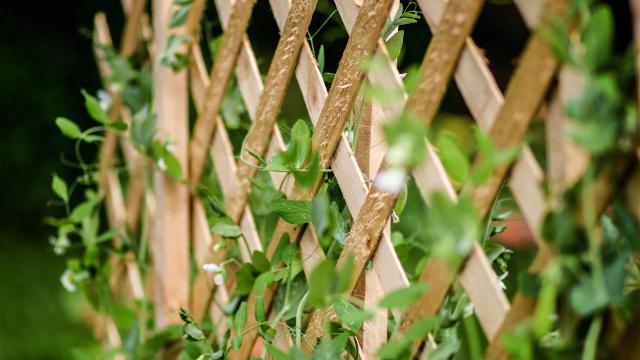It’s the time of year when gardeners are itching to get some plants in the ground — but if you live in a climate zone where it’s still too early, there’s another project you can tackle now to kick-start this year’s garden. If you’re looking to maximise your space, take advantage of more direct sunlight, or just design your garden to be more attractive, a trellis is a great solution.
Some plants are designed to climb, such as pole beans, peas, and nasturtium. Giving them a structure will ensure proper growth and, in the case of vegetables, a higher yield. But other plants can be grown on trellises, as well, by training the vines. Using a trellis to take your garden vertical can improve yield and make the best use of a small space. You can also put up more permanent trellises to grow a privacy screen or to double as a fence.
What materials do you need to build a trellis?
Since a climbing vine will often climb almost anything, there are many materials, from wood to metal, to choose from when designing a trellis. Choosing a material that is both cost-effective and sturdy enough to hold up your plants is the key: Remesh, bamboo, and pre-cut steaks are a good place to start to both save some money and create a sturdy structure that will last.
The most difficult part of building a trellis is getting it to stay upright. There are a couple of solutions for this problem, but using a solid fence stake will help. For a single panel of flat trellis, you’ll just need two stakes, some baling wire or other sturdy wire, and one panel of remesh or hog fence at your desired height and width. These wire mesh products come in a variety of sizes, but you can also trim them to fit your needs with a hack saw or a sturdy pair of wire cutters.
How to build a garden trellis
Once you’ve chosen your size, drive your fence posts into the ground at each corner where you want to place your trellis. You can use a fence post driver or a heavy mallet, and make sure to sink them at least 1-2 feet into the dirt to build a sturdy structure. Then, you can attach your wire mesh to the posts with the metal tabs provided and some baling wire at the top and bottom corners for stability.
To build a simple arch-shaped trellis, you can use a similar method by doubling the number of fence stakes and using a longer piece of wire mesh. Drive your posts at the bottom two corners of your arch, and attach the ends of the mesh to each pair of posts at the bottom and about 4-5 feet from the ground. This is a way to add some beautiful space for your climbing flowers or some extra space for your veggies.
You can also use bamboo stakes to hold up your trellis. The advantage to bamboo is its more natural look and that it can be easily trimmed to whatever height you want with a handsaw or chop saw. Follow the same steps as with the metal stakes, using your baling wire to hold the mesh sheets in place. If you’d rather avoid metal all together, bamboo mesh is also an alternative.
Important safety note: Before you start digging, be sure to check the ground for pipes and wires — most municipalities have a public service that will do that for you before a dig. Breaking a sewer pipe is definitely not a good start to the gardening season.

Leave a Reply
You must be logged in to post a comment.